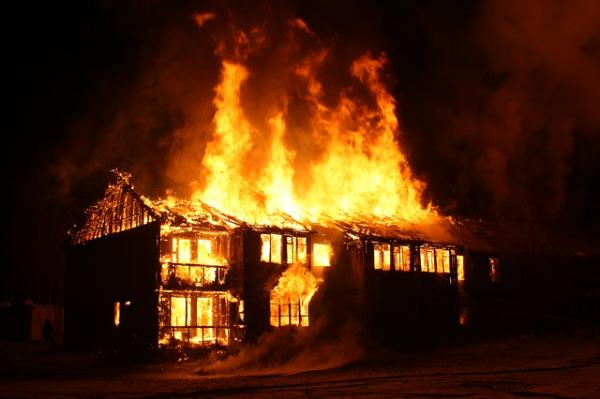
A recent news article claimed that "organic" furniture is less likely to kill you in a house fire because "synthetic" materials will burn up to 8 times faster. It was accompanied by a video from the Underwriter Laboratories (UL) certification company (1) and a quote from a fire captain in Arkansas (2) which suggested they were both affirming the claim was true.
Let's find out.
According to the National Fire Protection Agency, there is a home fire every 86 seconds. That is 1,000 per day in a country of 330,000,000 people. Cooking is the leading cause of home fires and injuries, but home fire-related deaths often involve furniture - because they often involve open flames or cigarettes and sleeping or alcohol. This has long been true which is why flame retardant chemicals became popular. Activists have lobbied against chemicals that made furniture safer, arguing that the number of lives saved was too inconsequential to allow chemical treatments on sofas. So now will they say that those lives are so important the country should rush to antique stores and replace their post-1950s furniture?
Claims that expensive solid oak furniture will save lives in a fire is indeed novel. There is one reason they can feel correct, and that is because solid wood does not burn as easily as people think. Unfortunately, they stopped learning science after that, as we'll see.
A fire has many forms - but there is good news about modern house fires
The claim about safety is novel because you are far less likely to die in a furniture-related house fire today than when furniture was more "organic." The number of upholstered furniture fires has actually decreased by 77% since the 1980’s, and the number of deaths attributable to those fires is down 61%, but furniture is still the number one burnable item in your home. It's made of wood after all.
Why is furniture so special in a fire? Despite what you may have read in the article I linked above, it is not because of the modern synthetic versus old organic issue, it is a problem known for thousands of years. That problem is flashover, an explosive-like eruption of flames which is responsible for most of the fatalities and property damage in residential fires. In the UL video below, the scenario is not accurate because an entire wall has been removed, allowing plenty of oxygen to make the wood burn faster, which is no more of a comparison than claiming using different wood in your fireplace will save lives.
In real houses, an entire wall has not been removed. Wood does not burn directly very well. To catch fire, heat must first decompose it, which releases flammable gases which combine with oxygen to create flames in a confined space and therefore a flashover explosion can occur. (3) The ancient Romans invented the first chemical flame retardants to coat siege towers and prevent them from catching fire. England granted the first flame-retardant patent, in 1735, but their use took off in the early 1970s because furniture production had become advanced enough everyone could now have durable furniture, regardless of income. It just couldn't be solid wood.
Brominated flame retardants - chemistry that saved lives in house fires
As a solution to concerns about increased flammability, brominated flame retardants, which remove free radicals in products and therefore reduce heat generation and the production of flammable gases, were added to make newer furniture even safer than its solid wood ancestors. They prevented a fire from erupting in the best case and slowed combustion substantially either way, much like a flu vaccine makes the flu far less deadly even if you still get it.
Flame retardants prevented or slowed flashover. And environmentalists promptly declared war on those because they are chemicals. But that is another story. (3)
What is important to remember that while Arkansas firefighters and environmentalists can laud their great-grandmother's furniture, most of the world has never been able to afford solid oak heirlooms. Low-priced furniture today is still much safer than furniture our grandparents had during a house fire. The presence of "petroleum" sounds scary, but it's meaningless in a chemical sense. Petroleum byproducts are actually used to help make clothing non-flammable, for example. Even if you inherited fantastic furniture, your paint is far safer now than it was in your great-grandparent's day but it is still latex or acrylic and can still cause flames to spread.(4)
The point is, fires can spread in any home and no, modern materials are not burning eight times faster than old homes did, no matter how a journalist watches a video and puts aside any skepticism about chemistry. Scaring people about furniture is not a solution. Promoting home fire safety and stopping the war on chemicals that prevent flashover is.
NOTES:
[1]
[2]
Firefighters in Rogers, Arkansas handle about 130 calls a year and their average response time is an impressive 4 minutes, 40 seconds. Obviously faster response times could also be part of the reason house fires are much less deadly today than in the past. There's no one I'd rather have show up if my house erupts in flames, but anecdotes should be not used in place of science.
[3] Fundamentals Of Fire Fighter Skills
[4] To be more specific, what are known as high-energy “free radicals” (i.e., H+ and OH- in the gas phase) break down molecules, freeing carbon atoms that react with oxygen (O2) and burn, releasing both carbon dioxide (CO2) and water (H2O). Source: Brominated Flame Retardants: A Burning Issue By William P. Kucewicz



